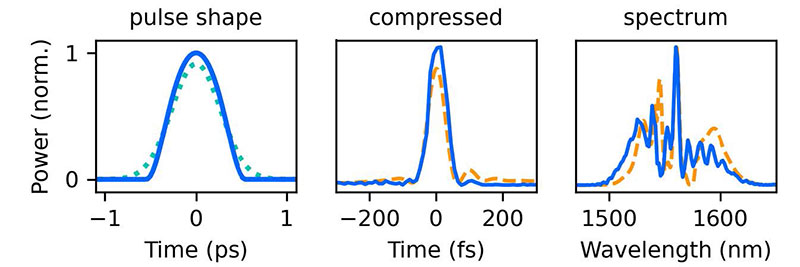Record output from telecom lasers reveals new pulse shape, as published in Optica
To read the full article, click here
IMRA researchers have discovered a new pulse shape that helped them achieve an order of magnitude increase in pulse energy from their telecom range, ultrashort pulse erbium fiber laser [1]. The new peak power is high enough to finally bring telecom lasers into the strong-field regime, where the electric field of the laser rivals the field from an atom holding onto its electrons.
Optical waveguides like telecom fibers or silicon nitride chips direct and control light within them, converting complex arrangements of mirrors and lenses into solid objects that can be assembled into a convenient practical device. Using waveguides at high intensities requires care though. Intense light temporarily changes the refractive index of the material, which can deteriorate pulse quality. To increase the pulse energy without triggering pulse breakup, the researchers adjusted the pulse being amplified so it would develop in a clean and predictable way at high pulse energies. They control the temperature profile of a chirped fiber Bragg grating pulse stretcher where the different colors of the pulse reflect at different points along the fiber. Heating a section slightly delays the colors reflecting there, which changes the shape of the pulse when the colors are reassembled later in the laser. They found that shaping the pulse into a Jacobi form was particularly useful. The new Jacobi pulse, named after the mathematical functions, has short tails, and a consistent curvature. This consistency extends to the nonlinear modification the pulse receives in the waveguide for easy pulse compression after leaving the waveguide. With shaping, they were able to crank up their laser energy ten times to a level of several hundred nJ, transforming what would be ruined pulses into clean ultrashort pulses just by adjusting the temperature, as further shown in the Figure.

Left: Comparison of Jacobi (solid) and Gaussian (dashed) pulse shapes; middle: experimental (solid) and theoretical (dashed) compressed 100 nJ Jacobi pulse; right: corresonding compressed 100 nJ Jacobi pulse spectra.
Conventional shapes like the Gaussian have long tails that waste energy, and pointy peaks that cause uneven nonlinearity. Jacobi pulses are compatible with almost any waveguide design and also frequency combs. The possible increase in the energy limits of waveguide based lasers and frequency combs will bring strong-field technology into the mainstream, with many new applications in electron control, semiconductor physics, and biotechnology.
References:
[1] K. F. Lee et al., Surpassing soliton compression limits in anomalous dispersion high power erbium fiber comb, Optica, Vol. 8, Issue 6, pp. 846-853 (2021)


